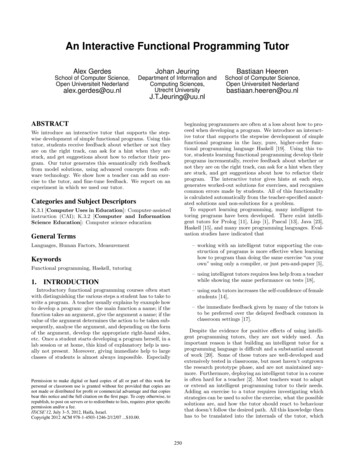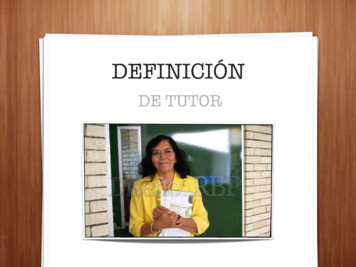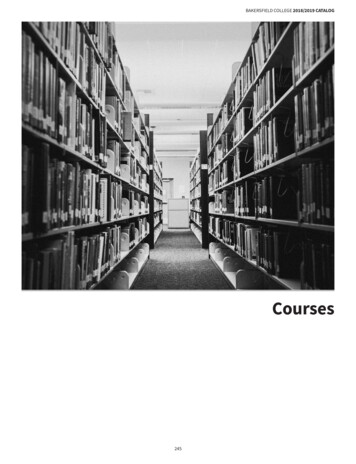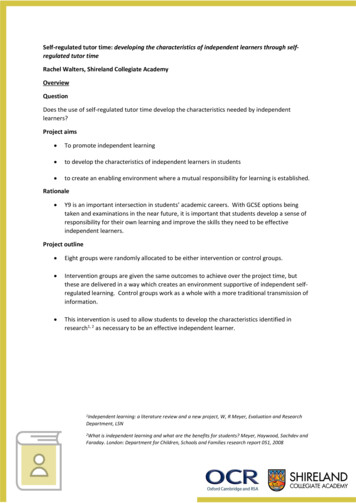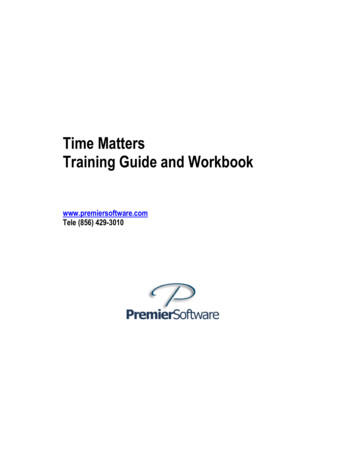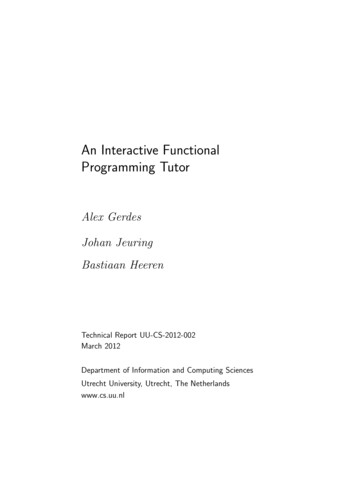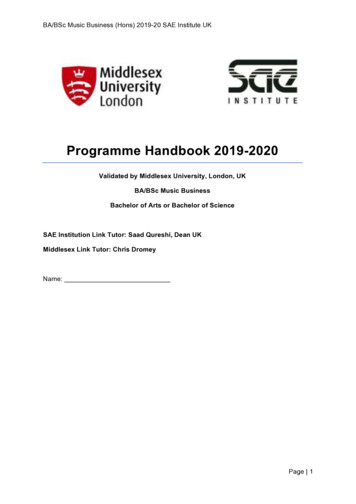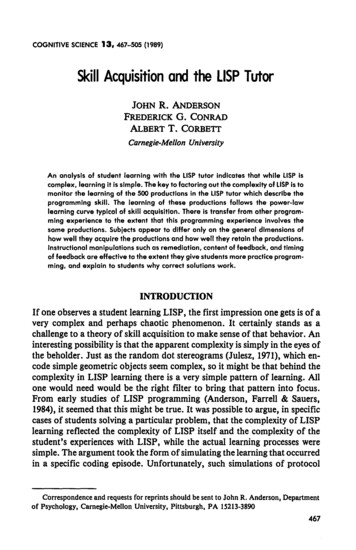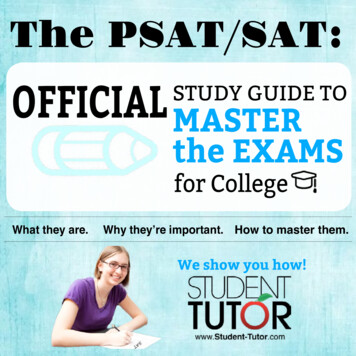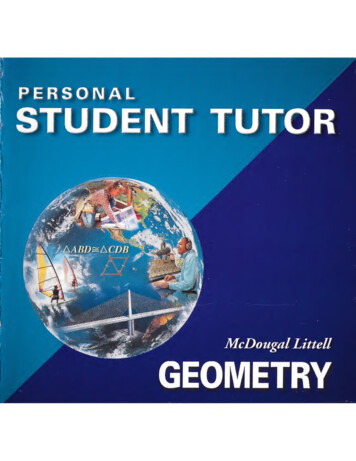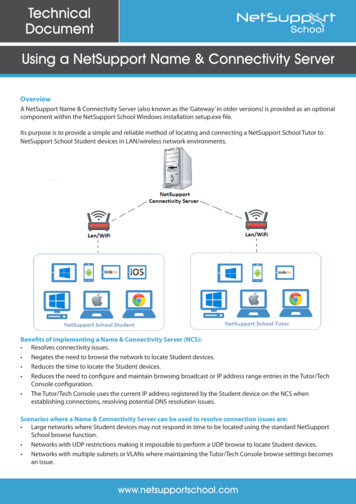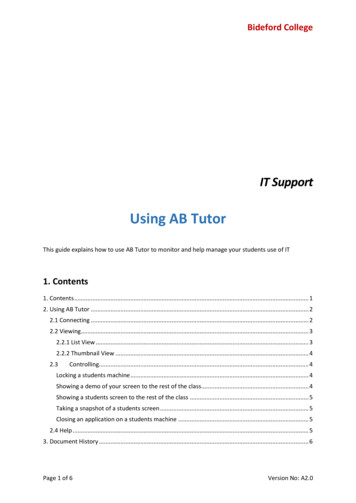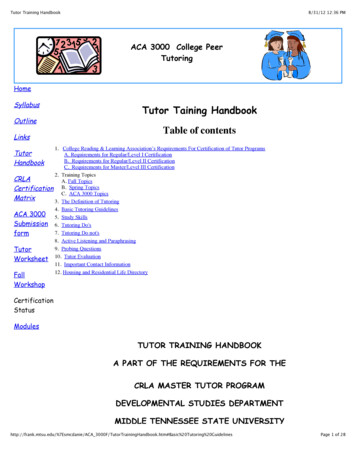
Transcription
Tutor Training Handbook8/31/12 12:36 PMACA 3000 College PeerTutoringHomeSyllabusOutlineLinksTutor Taining HandbookTable of contents1. College Reading & Learning Association’s Requirements For Certification of Tutor ProgramsA. Requirements for Regular/Level I CertificationB. Requirements for Regular/Level II CertificationC. Requirements for Master/Level III Certification2. Training TopicsCRLAA. Fall TopicsCertification B. Spring TopicsC. ACA 3000 TopicsMatrix3. The Definition of Tutoring4. Basic Tutoring GuidelinesACA 3000 5. Study SkillsSubmission 6. Tutoring Do's7. Tutoring Do not'sform8. Active Listening and Paraphrasing9. Probing QuestionsTutorWorksheet 10. Tutor Evaluation11. Important Contact Information12. Housing and Residential Life tusModulesTUTOR TRAINING HANDBOOKA PART OF THE REQUIREMENTS FOR THECRLA MASTER TUTOR PROGRAMDEVELOPMENTAL STUDIES DEPARTMENTMIDDLE TENNESSEE STATE UNIVERSITYhttp://frank.mtsu.edu/%7Esmcdanie/ACA 0GuidelinesPage 1 of 28
Tutor Training Handbook8/31/12 12:36 PMMIDDLE TENNESSEE STATE UNIVERSITY2000-2001Compiled and/or Authored byMeredith Anne S. HiggsScott Noble McDanielTutor Training Co-coordinatorsCRLA Master Tutor Training ProgramCollege Reading & Learning Association’s RequirementsFor Certification of Tutor ProgramsRequirements for Regular/Level I CertificationA.B.Amount/Duration of Tutor Training: (one of more of the following)1.Minimum of ten hours of tutor training2.A quarter/semester tutor training course3.A quarter/semester of tutor training (non-course work)Modes of Tutor Training1.Classroom and/or workshop instructionPLUS any combination of the following:2.Tutor training videotapes3.Conferences with tutor e/ACA 0GuidelinesPage 2 of 28
Tutor Training Handbook8/31/12 12:36 PMC.3.Conferences with tutor trainer/supervisor4.Special tutor projects5.OtherAreas/Topics to Be Covered in Tutor Training:(A minimum of eight of thefollowing topics should be covered in Level I training)D.1.Definition of tutoring and tutor responsibilities2.Basic tutoring guidelines3.Techniques for successfully beginning and ending a tutor session4.Some basic Tutoring “Do’s”5.Some basic Tutoring “Do Not's"6.Role modeling7.Setting goals/planning8.Communication skills9.Active listening and paraphrasing10.Referral skills11.Study skills12.Critical thinking skills13.Compliance with the ethics and philosophy of the tutor trainingprogram14.Modeling problem solving15.OtherRequired Tutoring Experience25 hours of actual tutoringhttp://frank.mtsu.edu/%7Esmcdanie/ACA 0GuidelinesPage 3 of 28
Tutor Training Handbook8/31/12 12:36 PMRequirements for Regular/Level II Certification(NOTE: Tutor must have completed Level I Certification Requirements)A.Amount/Duration of Tutor Training: (one of more of the following)1.Minimum of ten hours of tutor training beyond Level I (a minimum ofcumulative hours of tutor training)2.A second quarter/semester tutor training course3.A second quarter/semester of tutor training (non-course work)20B.Modes of Tutor Training1.Classroom and/or workshop instructionPLUS any combination of the following:C.2.Tutor training videotapes3.Conferences with tutor trainer/supervisor4.Special tutor projects5.OtherAreas/Topics to Be Covered in Tutor Training(In addition to reviewing the topics covered in Level I, a minimum of fourof the following topics should be covered in Level II training)1.Review of Level I topics2.Use of probing questions3.Characteristics of adult learners/learning styles4.Cultural awareness and inter-cultural communications5.Identifying and using resources6.Tutoring in specific skill/subject areas7.Record anie/ACA 0GuidelinesPage 4 of 28
Tutor Training Handbook8/31/12 12:36 PMD.7.Record keeping/documentation8.OtherRequired Tutoring ExperienceTwenty-five additional hours of actual tutoring after completion of all LevelI requirements (a minimum of 50 cumulative hours of actual training).Requirements for Master/Level III Certification(NOTE: Tutor must have completed Level I and II Certification Requirements)A.Amount/Duration of Tutor Training: (one of more of the following)1.B.Minimum of ten hours of tutor training beyond Level II (a minimum of30cumulative hours of tutor training)2.A third quarter/semester tutor training course3.A third quarter/semester of tutor training (non-course work)Modes of Tutor Training1.Classroom and/or workshop instructionPLUS two or more of the following:C.2.Tutor training videotapes3.Conferences with tutor trainer/supervisor4.Special tutor projects5.OtherAreas/Topics to Be Covered in Tutor Training(In addition to reviewing the topics covered in Level I and II, a minimum of fourhttp://frank.mtsu.edu/%7Esmcdanie/ACA 0GuidelinesPage 5 of 28
Tutor Training Handbook8/31/12 12:36 PM(In addition to reviewing the topics covered in Level I and II, a minimum of fourof the following topics should be covered in Level III training)D.1.Review of Level I and II topics2.Assertiveness training3.How to tutor/deal with target populations4.How to administer and interpret a Learning Styles Inventory5.Structuring the learning experience6.Training and supervising the other tutors (supervisory skills)7.Group management skills (group interaction and group dynamics)8.OtherRequired Tutoring ExperienceTwenty-five additional hours of actual tutoring after completion of all Level Iand II requirements (a minimum of 75 cumulative hours of actual training)Middle Tennessee State University’s CurriculumFor the College Reading and Learning Association’sMaster (Levels, I, II, and III) Tutor Training ProgramThe standard program consists of 30 hours of training including 6 hours in the fall in-service,8 hours in the spring in-service, 15 hours in the course, and 1 hour of on-the-job training orsupervisor training in specific content area. The program may be altered to accommodatespecific tutors and supervisors needs. Training will be multi-modal including classroominstruction, workshop participation, conferences with supervisors, tutor projects, and handson activities.*The fall Tutor Training In-service will have six total hours of training. Topics and alternatetopics are listed below.http://frank.mtsu.edu/%7Esmcdanie/ACA 0GuidelinesPage 6 of 28
Tutor Training Handbook8/31/12 12:36 PMtopics are listed below.Fall Training Topics-Modeling or Problem Solving-Communication Skills-Ethics and/or Philosophy of tutoringFall Training Alternate Topics-referral skills-identifying and using resources-role modeling-setting goals-goal planning-record keeping and documentation-training and/or supervising tutors*The spring Tutor Training In-service will have eight total hours of training. Topics andalternate topics are listed below.Spring Training Topics-Adult learners or learning styles-Cultural awareness and inter-cultural communications-How to tutor and/or how to deal with target populations-“Other” concerns-Students with disabilities and special needs-Group management skillshttp://frank.mtsu.edu/%7Esmcdanie/ACA 0GuidelinesPage 7 of 28
Tutor Training Handbook8/31/12 12:36 PMSpring Training Alternate Topics-referral skills-role modeling-setting goals-goal planning-record keeping and documentation- training and/or supervising tutors*The ACA 3000 tutor training course and handbook will have fifteen total hours of training.Topics are listed below.ACA 3000 Training Topics and Handbook Topics-Definition of tutoring-Basic tutoring do’s-Basic tutoring do not’s-Study skills-Active listening and paraphrasing-Probing questions-Learning styles inventory-Important contact information-The Master Tutor Programhttp://frank.mtsu.edu/%7Esmcdanie/ACA 0GuidelinesPage 8 of 28
Tutor Training Handbook8/31/12 12:36 PMThe Definition of TutoringTutoring is a loaded term. Tutoring means very different things to different people.Some believe that tutors are replacements for teachers. Others believe that tutors aresupposed to do their homework for them. Others still may view tutors as support personnel.Given all of these conflicting views of tutoring, review your own definition of tutoring.As tutor, what are your responsibilities? In other words, what does "being a tutor" mean toyou? List five things that you associate with tutoring.1.2.3.4.5.Compare your list with a partner. Do any items on the lists overlap?Webster's New World Dictionary (1988) defines a "tutor" as "a teacher who givesindividual instruction to a student." Tutors are a vital part of the educational supportnetwork in any institution. Tutors have the time an energy to provide one-on-one instructionoutside of the classroom setting. Many students would not succeed in college if tutors werenot available.This handbook will provide some basic tips, strategies, and activities to guide youthrough the tutoring process. Information will include Contact Information, Basic TutoringGuidelines, Tutoring Do’s and Tutoring Do Not’s, Study Skills, Active Listening andParaphrasing, Probing Questions, and Learning Style Inventory.Webster's New World Dictionary (1988)(Victoria Neufeldt, Ed.) Simon & Schuster, Inc:http://frank.mtsu.edu/%7Esmcdanie/ACA 0GuidelinesPage 9 of 28
Tutor Training Handbook8/31/12 12:36 PMWebster's New World Dictionary (1988)(Victoria Neufeldt, Ed.) Simon & Schuster, Inc:Webster's New World Dictionary: New York, New York. p.1443.Basic Tutoring Guidelines1.Remember that as a tutor you are an additional resource to help students succeed. Yourtime and efforts are valuable. You are important.2.Remember that tutoring is a responsibility. Your tutee’s time and efforts are valuable aswell.3.When tutees repeatedly ask simple questions, remember that the only stupid question isthe one that was not asked.4.Patience. Patience. Patience.5.If you do not know the answer, ask another tutor, lab director, supervisor, or instructor;remember that the only stupid question is the one that was not asked.6.Anger has no place in the tutoring environment. Create a positive learning environment.7.Harassment of any kind has no place in the tutoring environment. Create a positivelearning environment.8.A tutor does not replace an instructor, nor does a tutoring session replace missed classtime.9.Always be on time for tutoring sessions or scheduled laboratory hours.10. The student must complete his or her own work. Make sure that you know how much tutorassistance is allowed on each assignment.11. Your lifestyle choices and value systems may not agree with your tutee’s. Be sensitive tothese differences and make sure that you do not impose your lifestyle choices and valuesystems on your tutee.12. Respect diversity.13. Respect your tutee.http://frank.mtsu.edu/%7Esmcdanie/ACA 0GuidelinesPage 10 of 28
Tutor Training Handbook8/31/12 12:36 PM14. Respect yourself.Can you think of any other basic tutoring guidelines? List them here and tell a tutoring cocoordinator.National Association of Tutorial Services Lab Assistant Code of Ethics. Tutor handbook,Columbia State University.Study SkillsMany students come to college with little study skills preparation. They may not have neededto study in high school or to be organized. Study skills and time management skills are crucialstrategies that you as a tutor can share with your tutees, and you may have more study andtime management skills than you realize.To be selected as a tutor, you must have a demonstrated academic record ofachievement. To have earned a demonstrated academic record of achievement, you mustutilize study and time management skills in everyday college life. Preparing for college studiesis like jumping through hoops at a circus; college studies may be challenging, but with theright tools, the hoops of college do not have to be on fire.Take a few minutes to contemplate how you study. How do you study for a test? How do youwrite a paper? Do the strategies that you use to study for a mathematics class also work foran English or History class? Why or why not?List the top five ways that you study or prepare for a class. Compare your list with apartner’s list.1.2.3.4.http://frank.mtsu.edu/%7Esmcdanie/ACA 0GuidelinesPage 11 of 28
Tutor Training Handbook8/31/12 12:36 PM5.Select the main study skill that you want to share with your tutees and circle it in the listabove. Be sure to share this study skill with all of your tutees.Many students find that making flash cards from 3” x 5” index cards is very helpful inmemorizing items of lists such as mathematics equations and history facts. However, moststudents have not made flash cards before; they will need instruction on how to use them.Consider how flash cards could be used to memorize a mathematical equation. The equationname should be written on one side of the card with the mathematics symbols and descriptionof the equation’s use on the other side. Using the index cards provided, make study cards forthe following information:1. Given any point on a line (X1, Y1) and the slope of the line (m), an equation for the linemay be written using the point-slope formula (Y- Y1) m (X - X1).2. Stahl is considered one of the founders of molecular biology. Watson and Crick discoveredthe DNA double-helix. Their discovery has forever changed the way that biology has beenstudied.Index cards are also very useful in writing English papers and compositions.Bibliographic information can be written on one side of the card with the main points orspecific quotes from the text on the other side. Entire papers can then be written by copyingthe information from the cards with the appropriate reference, organizing the ideas, andadding an introduction, transitional sentences, and a conclusion.Describe one tutoring situation where you would highly encourage a tutee to use flashor index cards.Time management is also a crucial skill for college students. For some people, timemanagement is a natural part of organizing the day. Others need instruction on how to decidehttp://frank.mtsu.edu/%7Esmcdanie/ACA 0GuidelinesPage 12 of 28
Tutor Training Handbook8/31/12 12:36 PMmanagement is a natural part of organizing the day. Others need instruction on how to decidewhat can and cannot be accomplished in one day.Consider the following list. Which items can be successfully completed in one evening?Mark a “C” next to those items. Which items do many college students try to complete in oneday? Mark a “T” next to those items. Do you notice any patterns?1.Three weeks-worth of laundry.2.Reading an entire semester’s worth of history assignments.3.Studying for a mid-term.4.Studying for a final.5.Writing an English paper.6.Reading an entire book for a class assignment.7.Writing a speech.Many students do not know to begin studying for a test or writing a paper several daysbefore it is due. Make sure that your tutees know some of the rules and strategies oftime management.1.Keep a daily planner with all appointments, assignments, and due dates.2.Schedule a specific time for homework and studying. Try to keep this time thesame throughout the week or coordinating with your class schedule (TR and MWF).3.Make a list of homework assignments and activities (extra-curricular, too!) to becompleted each day. Plan specific amounts of time for each assignment or activity.Use this checklist to gauge your progress during the day.4.Allow extra time for big tests and projects. They always take longer than youexpect.5.Plan to review information or practice problems from a class within one hour, withinone day, within one week, and within one month.http://frank.mtsu.edu/%7Esmcdanie/ACA 0GuidelinesPage 13 of 28
Tutor Training Handbook8/31/12 12:36 PMTutoring Do’sThere are several things as a tutor that one should do in order to maximize the experiencefor the student listed below are some basic characteristics and mannerisms that a good tutorshould posses:Punctuality: If meeting one-on-one, the tutor should certainly set an example by beingon time. If working in a drop in lab, the tutor should be on time and ready to beginhelping the other tutors.Honesty: Don’t hesitate to say that you do not know about a particular concept. Tryingto bluff your way through will only hurt the student and your reputation in the long run.Enthusiasm: If the tutor does not display a love for the subject they are tutoring, howcan they expect the student to enjoy it. Come to the lab with a positive attitude thatwill rub off on the students.Hard work: Make sure you are familiar with the textbooks and the computer softwarethat is available to students. This may take some time while you are not on the clock.Listening: The tutor should develop good listening skills so that they will betterunderstand students’ misconceptions and errors.WillingnessMaintain academic standardsGood personal hygiene: If you smoke, you may want to use a breath mint.Mobility: Tutors should make themselves mobile if in an open lab. You should movequietly about the room at least 4 times during a 1 hour lab session. This helps thestudent get easier access to the tutorGood questioners: The tutor should ask the student questions in order to evaluate astudents understanding (see section on probing questions).Encourage independence: You do not want the student to rely on you at all times. Letthem know that they must put forth an effort to benefit from tutoring.Patience: This is probably one of the most important characteristics of a tutor. Neveract annoyed that the student does not know something. Even if they ask the most basicquestion, always demonstrate your patience.Maintain confidentiality: Any personal information such as medical conditions, handicaps,test sores should be between only you and the student.Introduce yourself and wear a name tag if in an open lab.Encourage the student to focus on learning how to learn.Encourage the students to identify several alternative study strategies from which tochoose.Do allow for periods of silence. Avoid feeling like you have to interrupt a moment ofhttp://frank.mtsu.edu/%7Esmcdanie/ACA 0GuidelinesPage 14 of 28
Tutor Training Handbook8/31/12 12:36 PMDo allow for periods of silence. Avoid feeling like you have to interrupt a moment ofsilence by talking. Allow the student to reflect on the subject at hand before going on.Tutoring Do Not'sSometimes a tutor can do more harm than good. Listed below are some things not to do whentutoring.·Do not assume the role of the instructor. You are only to help them not replace them. Youare only an assistant. As the assistant you are in the position to greatly enhance astudents perception and understanding of a subject.·Do not think of yourself as the dispenser of all truth and knowledge. Try to relate to yourtutees as equals. Do not talk about all of the upper level course that you have had (unlessthey ask about it).·Do not judge someone's ability or intellect based on appearance or age.·Do not allow your tutees to just scrape by. Challenge them to reach for the "A" instead ofsettling for a C.·Do not use the tutoring lab as your personal dating service. This could do more than justhurt the students' grades; it could jeopardize your future.·Do not let one student monopolize all of your time if your are in a drop in lab setting.Remember that you are trying to enable the student to become an independent thinker.This can't be done if they use you as a crutch the entire time.·Do not introduce fancy ways you learned in your upper level classes to help the studentssolve their problems. Stick as close as you can to the way the instructor did it. If thereis a slight variation that you know has worked well with others, you may want to share it,but be cautious! It is always safe to show them the way their instructor did it.·Example: You may want to show a student another way to get a common denominator whenadding or subtracting basic fractions. But you would not want to introduce limits toinfinity to help an algebra student find asymptotes.·Do not just sit in the chair staring out the window when there are students in the lab.This lackadaisical method discourages students form asking you questions .http://frank.mtsu.edu/%7Esmcdanie/ACA 0GuidelinesPage 15 of 28
Tutor Training Handbook8/31/12 12:36 PMThis lackadaisical method discourages students form asking you questions .·Do not work the students' assignments for them. In math, you nay want to make up similarproblems to work as examples and let them do the actual homework. For writingassignments you will want to make sure that you do not write their paper nor provide themain ideas for them. You should only be helping them generate their own ideas and helpingthem with the structuring of their paper.The following were adapted from Guidelines for Math Lab assistants from Columbia StateCommunity College andActive Listening and Paraphrasing[1]Your role as a tutor is multifaceted indeed. Not only are you expected to know everything thestudent brings to you, but you should also be able to explain it in a way that they willimmediately understand. One of the most important abilities you will need to develop are thecommunication skills of active listening and paraphrasing.Active (or attentive) listening demonstrates respect by giving the student your full attention.This makes the student feel that they are important. It also communicates actively by usingpositive nonverbal signals such as eye contact, posture, and body language. Not only shouldyou be conscious of your nonverbal signals but your clients’ as well. Listen carefully to all ofthe messages being sent. How you act is sometimes as important as what you say. You shouldcreate an atmosphere of appearing interested in helping the student. Remember, if you aredoing most of the talking, something is wrong.http://frank.mtsu.edu/%7Esmcdanie/ACA 0GuidelinesPage 16 of 28
Tutor Training Handbook8/31/12 12:36 PMIn class activity: Make two columns: one listing good active listening traits, the other badlistening traits. We will roll play both and discuss what we see.Paraphrasing communicates accurately what is heard by reflecting and then summarizing.Organizing the tutees’ remarks into one concise statement involves listening completely to thetutees’ own concerns and then summarizing the problem—hopefully providing new light to thetutee.Some good phrases to use might be:“What I hear you saying is ”“It seems to me what you are saying is ”“You sound ”“It sounds to me like ”It is sometimes important for the tutor to summarize when the student has all theinformation “on the table” but might not know it. If possible, try to get the student to do theparaphrasing. Again, the more talking that you do, the more reliant the student will be on you.Probing QuestionsIn order to assess students’ knowledge, it is important that tutors pose good questions. Thetutor should explain the concepts but should be careful not to work to many problems.Questioning should encourage students to work problems out on their own.http://frank.mtsu.edu/%7Esmcdanie/ACA 0GuidelinesPage 17 of 28
Tutor Training Handbook8/31/12 12:36 PMThere are two types of questions: closed-ended questions and open-ended questions.Closed ended questions: usually have short responses like “yes” or “no”. This type ofquestioning is good if you are short on time and have several other students to attend to in adrop in lab. Closed-ended questions typically do no lead to other questions or discussion.EXAMPLE: Are you passing algebra class?Open-ended questions: encourages more interaction. They usually require an explanation fora response and may lead to further questions, hopefully revealing the true cause of themisunderstanding. Open-ended questions are good if the tutor has plenty of time to spendwith the student, but, with experience, can still be done in an open lab setting.EXAMPLE: Why do you think you are not passing Algebra class?In order to make the student interested in the subject you are tutoring one should do theirbest to actively engage the student in the learning process. One should not merely lecture onsome isolated topic such as adding positive and negative integers without first trying to usethe students’ own experience. One may ask questions that will help students develop theconcept.Example: If you take 3 steps north and 2 steps south, how fare are you from the startingpoint?Questions of this ilk will help the student discover and develop the concept for himself.After being asked several similar questions, he may be able to generalize a way to add positiveand negative integers. It was once said that what you have been obliged to discover byyourself leaves a path in your mind which you can use again when the need arises.In order to encourage the student to think, the tutor should avoid questions with a yes or noanswer. The tutor must also demonstrate patience. Questions that require thought will takehttp://frank.mtsu.edu/%7Esmcdanie/ACA 0GuidelinesPage 18 of 28
Tutor Training Handbook8/31/12 12:36 PManswer. The tutor must also demonstrate patience. Questions that require thought will takemore than the usual 5-10 seconds. While the student is answering the question, the tutorshould listen very carefully. The student is demonstrating exactly what he knows at thismoment. The tutor should also avoid question like “Do you understand?” or “Is that clear toyou?” Make the student demonstrate the concept by either working out another example (ifit’s math) or clearly showing he understands a particular writing concept.Suppose a student came to you with the problem below. How would you help him/her.Example: Find the vertex of the function:.Write down 3 or more questions that you feel would lead the student to, no only the correctanswer, but also the understanding of how to work another one of the same type.1.2.3.This does require a lot of patience on the tutors part. It would certainly be easier for thetutor to simply work the problem for the student. But these types of probing questions allowthe student to do most of the thinking, which will hopefully provide a stronger foundation.http://frank.mtsu.edu/%7Esmcdanie/ACA 0GuidelinesPage 19 of 28
Tutor Training Handbook8/31/12 12:36 PMTutor EvaluationThe CRLA Tutor Training program requires that tutors be continually evaluated. Ask yourlab director or supervisor how you will be evaluated.For example, the Developmental Studies Math Lab has used a computerized form such asthe one which follows.Sample Math Lab Tutor EvaluationThe Math lab Tutor Evaluation form is computerized. Whenever students log-out of thecomputer, a questionnaire appears.The Help WasWeakFairAverageGoodExcellentValues for the ratings range from 0 (Weak) to 4 (Excellent).http://frank.mtsu.edu/%7Esmcdanie/ACA 0GuidelinesPage 20 of 28
Tutor Training Handbook8/31/12 12:36 PMDEVELOPMENTAL STUDIES FULL-TIME FACULTYChair - Dr. Carol Bader - PH 217, Box 16, Phone-2568NameAlley, VivianAnton, HarleyAreaBadley, BillBrien, NancyClark, LindaMathReadingDir)WritingMathMathDawson, CarolDonnell, BirdieDooley,MathMathMathJenniferFisher, LawannaFlanigan, CherylOfficePH 235(Lab PH 231MathWriting (LabDir)Harrison, Jason MathHiggs, Meredith MathHopper, Carolyn Study Skills(writing labdir.)Hunt, CrosbyWritingLucas, MarvaMathMcDaniel, Scott MathOtto, SheilaWritingOtts, DavidMathRoss, Georganne ReadingRouse, JosephMathSundeen, Terry MathWilliams,MathAnnetteWomack, Morris MathBox376354Phone55572208PH 203SAG 122SAG 10328124616SAG 119SAG 124PH 229161616299857639048234555357625559SAG 115PH 2301642855522654PH 359SAG 122APH 2411616171525325502157PH 232SAG 117SAG 118PH 240SAG 116PH 242SAG 202ASAG 120SAG 19558259045558SAG 1041145554–DEVELOPMENTAL STUDIES ADVISORShttp://frank.mtsu.edu/%7Esmcdanie/ACA 0GuidelinesPage 21 of 28
Tutor Training Handbook8/31/12 12:36 PMDEVELOPMENTAL STUDIES ADVISORSNameGray, LewisHatfield, CarlaHensley, BarbaraRaffo, DeanaTempleton, MarkTharp, TerriOfficePH 102EPH 102FPH 102DPH 102CPH 102APH VELOPMENTAL STUDIES LABORATORIESMath LabReading LabWriting LabSAG 202KOM 124PH 3062465No Phone2212HOUSING AND RESIDENTIAL LIFE DIRECTORYHousing Office: 898-2860Area 3 Coordinator: Jennifer Danylo 898-3812Cummings HallFront Desk: 898-4201Resident Directors:Kris Rushing 898-3033John Norell 898-8454Academic Advisor:Rachel Duncan 904-8436http://frank.mtsu.edu/%7Esmcdanie/ACA 0GuidelinesPage 22 of 28
Tutor Training Handbook8/31/12 12:36 PMRachel Duncan 904-8436Tutors:Erin Elkins 898-4344Alicia Reed 898-4955Thuc Le 898-4975Jim Wilburn 898-4161Brooks Bowers 898-4055Bill Mann 898-3313Corlew HallFront DeskResident Director:Crystal CowardAcademic Advisor:Dana Moore 904-8556Tutors:Charmaine Woods 898-3956Jacquese Booker 898-4091Matt Walker 898-4083James Moore 898-3402Mike Cook 898-3489Introduction to the Tutoring
Harassment of any kind has no place in the tutoring environment. Create a positive learning environment. 8. A tutor does not replace an instructor, nor does a tutoring session replace missed class time. 9. Always be on time for tutoring sessions or scheduled laboratory hours. 10. The student must complete his or her own work.
